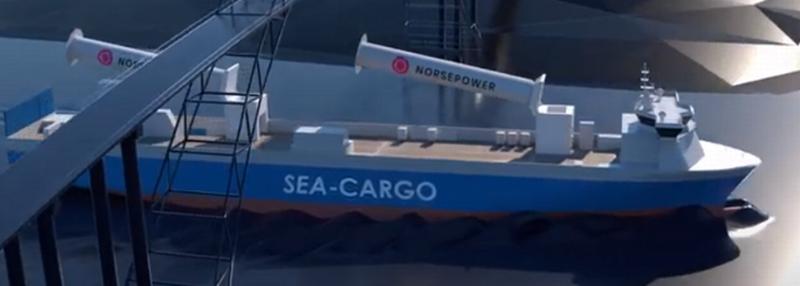 Sea-Cargo now has bragging rights to the claim that their 12,251 gross tonne ro-ro, SC Connector, is “Norway’s largest sailing vessel.” The ship was recently refit with two rotor sails by Norsepower and battery banks from Norwegian Electric Systems. The ro-ro now has taller masts and greater tonnage than the Norwegian sail training ship, Statsraad Lehmkuhl, which can still claim the title of the “largest three masted barque from Norway.”
Sea-Cargo now has bragging rights to the claim that their 12,251 gross tonne ro-ro, SC Connector, is “Norway’s largest sailing vessel.” The ship was recently refit with two rotor sails by Norsepower and battery banks from Norwegian Electric Systems. The ro-ro now has taller masts and greater tonnage than the Norwegian sail training ship, Statsraad Lehmkuhl, which can still claim the title of the “largest three masted barque from Norway.”
Perhaps the most interesting thing about the SC Connector, is how it succeeds in navigating under bridges and powerlines with its new 35-meter tall rotor sail rig. This is not a new problem. On May 11, 1878, for example, the US Navy training ship USS Minnesota lost the tip of her main top-gallant mast when she struck one of the suspension cables strung between the bridge towers of the still-under-construction Brooklyn Bridge.
SC Connector sails between Western Norway, Denmark, the Netherlands and, also, Sweden and Poland, and transits under multiple bridges and powerlines. Norsepower and Sea-Cargo developed a design for rotor sails that tilt to almost horizontal when required. The rig is designed for the extreme conditions in the North Sea and allows the rotors to be raised and lowered while sailing.

When in operation, the rotor sails are expected to achieve a fuel consumption, fuel cost, and carbon emissions reduction of up to 25%. In good wind conditions, the sailing vessel will maintain regular service speed by sail alone. Norsepower’s Rotor Sail Solution is a modern version of the Flettner rotor, a spinning cylinder that uses the Magnus effect to harness wind power to propel a ship.

So the story says “largest three mastered barque from Norway.”
Yet the pictures and video show ships with two. A cut and paste with out proof reading? Just curious
The link to the Statsraad Lehmkuhl shows a three-masted barque.
https://en.wikipedia.org/wiki/Statsraad_Lehmkuhl
Hi; STRATSRAAD LEHMKUHL is in fact a barque as she is the base from which all barques come subsequent will have 4 or 5 masts. That is the correct description she happens to be the largest sailing ship of any description in Norway, they also maintain the ships SORLANDET, CHRISTIAN RADICH and GEORGE STAGE all four are square riggers.
When we were in the southern oceans on the approach to Cape Horn in EUROPA 2015 we cam across ENERCON which looked not unlike SS CNNECTOR she was also in the trade of transporting parts for windfarms, I understand these vessel types are descendants of the Fletnor Rotor ship of the 1920s the ahead of its time and an unsuccessful type, I believe the Cousteau organisation had a foray into this are some years ago.
ENERCON’s EShip 1 is similar to the SC Connector but with 4 shorter Flettner rotors. I wonder how she did in the Southern Ocean winds. Cousteau developed a ventilated wing sail that looks similar to the Flettner rotor but acts more like a conventional sail. The Dutch firm eConowind is developing an updated version.
http://www.oldsaltblog.com/2019/09/dutch-shipowner-investing-in-new-ventifoil-wind-assist-technology/
« Statsraad Lehmkuhl … the “largest three mastered barque from Norway.”
— Do the masters rotate watches, 4 hours on, 8 hours off or do they split the cruises between them? In any event, she must be the only three-mastered three-masted barque in the world…